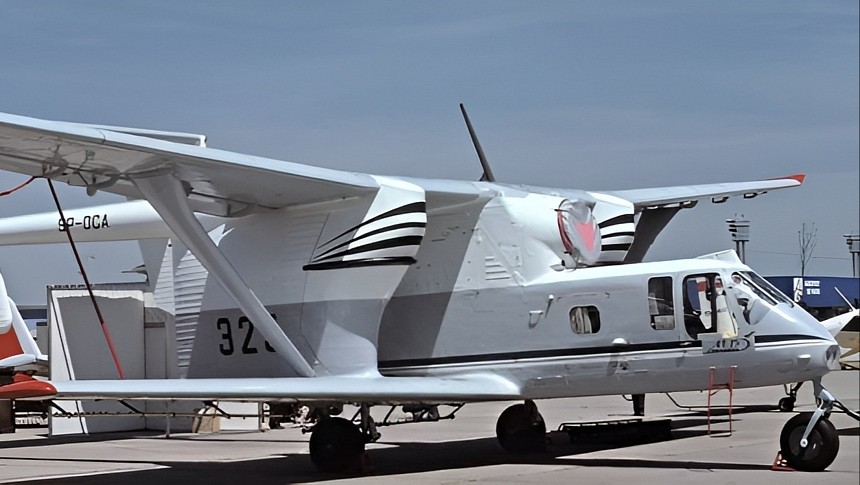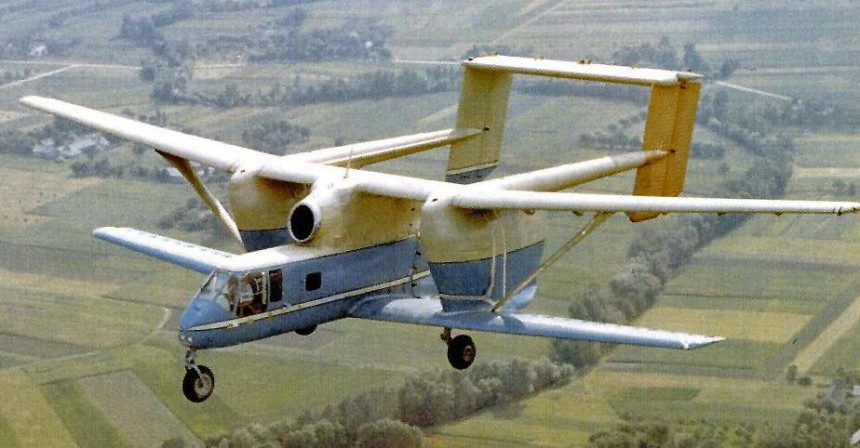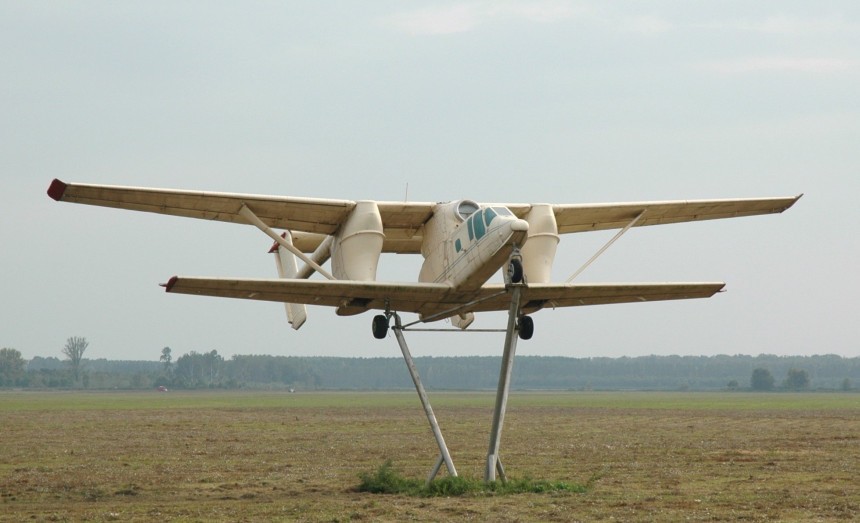Jet turbine airplanes tend to be built for one reason alone, speed. Why even bother employing the use of one for any other reason? Right? Well, that wouldn't explain the existence of the PZL M-15 Belphegor. With a top speed no better than that of the average family hatchback, the M-15 is a flying contradiction. That's why you ought to know the whole story.
To understand why a Polish aerospace firm would even try fitting a turbofan engine inside an agricultural sesquiplane, we need to understand what it was like living in Poland from the early 1970s to the early 80s. By this point in history, the Polish state had spent the last century-plus being tossed around between the regional powers of Tsarist Russia and the Prussian Habsburgs, only to bear the brunt of communism, fascism, and then communism again, all in the span of a few decades.
This kind of extreme turmoil could have brought any nation to its knees. But by the early 1970s, Poland was amid a newly emerging national identity with a blossoming automotive and aerospace industry to go along with it. By this point, the Central European state had gained a fair degree of autonomy inside the larger Warsaw Pact. Significant reforms in the years after the death of Stalin saw a profound rise in semi-independent Polish industries, which supplied nearly enough agriculture to feed its populace and even provided a substantial sum of crops to the Soviets.
Whether these grain imports to the Soviets were voluntary is another can of worms. But one way or another, those vast fields of wheat and barley needed to be sprayed with pesticides and fertilizer if people wanted it to get from farm to table. Since the end of the Second World War, this job most often went to the Antonov An-2 biplane utility aircraft. To say the An-2 is like a Soviet Model T in the sky wouldn't be an understatement. Over 18,000 were manufactured between 1947 and 2001.
The bespoke An-2R variant was specially engineered for agriculture service. Its main chemical tank could hold up to 1,300 kg (2,900 lbs) of powdered or liquid fertilizers and pesticides. This variant was manufactured primarily in the Soviet Union but also China and Poland. The slow, stable bi-plane was ideally suited for farm work by nearly all measures. Its forgiving handling characteristics and low stall speed gave pilots all the time they needed to hold the plane steady and drop chemical payloads with precision.
But there was a problem. These An-2Rs couldn't run forever, could they? More to the point, 70s-era Soviet and Polish state-owned collective farms, known as sovkhoz or kolkhoz, were growing genuinely vast. Not the work a lumbering piston-engine jalopy is well suited to accommodate. At least, according to some in high positions of Warsaw Pact governments in the early 70s. The Kremlin desired an aircraft that brought contemporary technology to the basic framework of the An-2R.
After deliberations between the Polish and Soviet governments, it was decided the WSK PZL-Mielec design firm of Mielec in Southeastern Poland would build a novel gas turbine-powered agricultural aircraft to supplement fleets of existing An-2Rs. Legend says that PZL engineers scratched their heads endlessly when they got the orders to shoe-horn a jet engine into the airframe of a crop duster. But, of course, orders from the Kremlin are just that. They just aren't to be questioned.
Ultimately, a single-engine sesquiplane with a top wing longer than the wing underneath was agreed upon. The first Polish test aircraft for the M-15 program, dubbed Lala-1, used the forward section of a PZL-produced An-2R. In contrast, the twin-boom rear section was custom fabricated to accommodate the new turbofan engine. With dimensions of 41 feet, nine inches (12.72 m) long, with a 73-foot, three-inch span of its top wing, the M-15 was slightly larger than the An-2R it was meant to supplement.
With a maximum takeoff weight of 12,456 lbs (5,650 kg), the M-15 was only a few hundred kilograms heavier as well. At the heart of this plucky Polish jet was an engine you'd have never expected to wind up in a glorified biplane. It's the Ivchenko-Progress AI-25, but you might know it better as the engine that powers the Aero L-39 Albatros. That's right, the same engine that powers the go-to millionaire's rent-a-fighter also powered the weirdest crop duster ever to see the light of day. 3,300 lbs (14.7 kN) of thrust was what the PZL M-15 had to work with.
Not an unhealthy sum by any means; keep in mind that the L-39 Albatross can reach speeds of just under Mach one with the same engine. But this speed obviously didn't translate to the M-15, whose top speed of 120 mph (193 kph) would get walked by a briskly-driven VW Golf with a long enough runway. Having two sets of wings, or more accurately, one and three-quarters, the M-15 had an exceptionally slow stall speed of 67 mph (108 kph). But even as the production-grade M-15 made its maiden flight on May 20th, 1973, it was clear proceedings wouldn't go smoothly.
Many problems were had by ground crews with the M-15's turbojet engine. For some context, the An-2's Shvetsov engine was developed from the American Wright R-1820 Cyclone of World War II fame. Therefore, they could typically be fixed with the toolset you'd use to repair a tractor engine. By comparison, Polish farmers found the more complicated turbofans in the M-15 to be a maintenance nightmare. Who could blame them, after all? They're not aviation mechanics, just humble farmers.
Flight performance was similarly poor, as were the operation and ownership costs. Overall, Polish and Soviet pilots and farmers seemed to find the M-15 a more cumbersome and far noisier An-2. The M-15 was so loud compared to piston-engine crop dusters that it's said its nickname, the Beplhegor, comes from the biblical demon known for its iconic droning howl. In the end, Soviet and Polish officials determined that not only was the Bephegor pretty much useless at crop dusting but also that the An-2, indeed, could operate indefinitely.
Even in 2023, upgrade programs to retrofit classic An-2s with newer, more efficient engines and fancy avionics upgrades continue to succeed in places where more expensive Western aircraft aren't an option. The type is even still in production, under license in China. Meanwhile, the Polish M-15's production wouldn't even make it ten years. The type was discontinued in 1981 without pomp or circumstance, with a measly 175 units built. The type was never operated outside of the Soviet Union or Poland despite a spirited campaign to sell the M-15 to other markets.
No M-15 Bephegors remain flying today, and only a handful remain on display in museums across Poland and modern-day Russia. Meanwhile, the An-2 will likely keep flying long past the time that all of us are just piles of bones.
This kind of extreme turmoil could have brought any nation to its knees. But by the early 1970s, Poland was amid a newly emerging national identity with a blossoming automotive and aerospace industry to go along with it. By this point, the Central European state had gained a fair degree of autonomy inside the larger Warsaw Pact. Significant reforms in the years after the death of Stalin saw a profound rise in semi-independent Polish industries, which supplied nearly enough agriculture to feed its populace and even provided a substantial sum of crops to the Soviets.
Whether these grain imports to the Soviets were voluntary is another can of worms. But one way or another, those vast fields of wheat and barley needed to be sprayed with pesticides and fertilizer if people wanted it to get from farm to table. Since the end of the Second World War, this job most often went to the Antonov An-2 biplane utility aircraft. To say the An-2 is like a Soviet Model T in the sky wouldn't be an understatement. Over 18,000 were manufactured between 1947 and 2001.
The bespoke An-2R variant was specially engineered for agriculture service. Its main chemical tank could hold up to 1,300 kg (2,900 lbs) of powdered or liquid fertilizers and pesticides. This variant was manufactured primarily in the Soviet Union but also China and Poland. The slow, stable bi-plane was ideally suited for farm work by nearly all measures. Its forgiving handling characteristics and low stall speed gave pilots all the time they needed to hold the plane steady and drop chemical payloads with precision.
After deliberations between the Polish and Soviet governments, it was decided the WSK PZL-Mielec design firm of Mielec in Southeastern Poland would build a novel gas turbine-powered agricultural aircraft to supplement fleets of existing An-2Rs. Legend says that PZL engineers scratched their heads endlessly when they got the orders to shoe-horn a jet engine into the airframe of a crop duster. But, of course, orders from the Kremlin are just that. They just aren't to be questioned.
Ultimately, a single-engine sesquiplane with a top wing longer than the wing underneath was agreed upon. The first Polish test aircraft for the M-15 program, dubbed Lala-1, used the forward section of a PZL-produced An-2R. In contrast, the twin-boom rear section was custom fabricated to accommodate the new turbofan engine. With dimensions of 41 feet, nine inches (12.72 m) long, with a 73-foot, three-inch span of its top wing, the M-15 was slightly larger than the An-2R it was meant to supplement.
With a maximum takeoff weight of 12,456 lbs (5,650 kg), the M-15 was only a few hundred kilograms heavier as well. At the heart of this plucky Polish jet was an engine you'd have never expected to wind up in a glorified biplane. It's the Ivchenko-Progress AI-25, but you might know it better as the engine that powers the Aero L-39 Albatros. That's right, the same engine that powers the go-to millionaire's rent-a-fighter also powered the weirdest crop duster ever to see the light of day. 3,300 lbs (14.7 kN) of thrust was what the PZL M-15 had to work with.
Many problems were had by ground crews with the M-15's turbojet engine. For some context, the An-2's Shvetsov engine was developed from the American Wright R-1820 Cyclone of World War II fame. Therefore, they could typically be fixed with the toolset you'd use to repair a tractor engine. By comparison, Polish farmers found the more complicated turbofans in the M-15 to be a maintenance nightmare. Who could blame them, after all? They're not aviation mechanics, just humble farmers.
Flight performance was similarly poor, as were the operation and ownership costs. Overall, Polish and Soviet pilots and farmers seemed to find the M-15 a more cumbersome and far noisier An-2. The M-15 was so loud compared to piston-engine crop dusters that it's said its nickname, the Beplhegor, comes from the biblical demon known for its iconic droning howl. In the end, Soviet and Polish officials determined that not only was the Bephegor pretty much useless at crop dusting but also that the An-2, indeed, could operate indefinitely.
Even in 2023, upgrade programs to retrofit classic An-2s with newer, more efficient engines and fancy avionics upgrades continue to succeed in places where more expensive Western aircraft aren't an option. The type is even still in production, under license in China. Meanwhile, the Polish M-15's production wouldn't even make it ten years. The type was discontinued in 1981 without pomp or circumstance, with a measly 175 units built. The type was never operated outside of the Soviet Union or Poland despite a spirited campaign to sell the M-15 to other markets.














